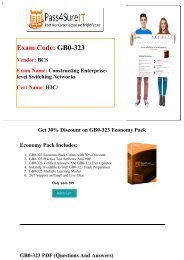Pass4Sure CCA-410 Exam Q&A Updated 2016
"pass4sureit provides you a chance to become a certified professional after getting your Cloudera CCA-410 certification. It provides you the most updated question and answers in PDF format for your Cloudera CCA-410 exam preparation. It doesn't provide you lengthy and outdated questions instead it provides you latest learning material and updates it regularly. pass4sureit provides you a comprehensive and customizable learning experience by giving you PDF format questions and answers that enables you to pass your Cloudera CCA-410 exam with full confidence and surety. PDF format questions and answers will improvise your knowledge and makes you more literate. After comprehensive study of these questions and answers you can justify your preparation by CCA-410 practice test. There are many sites which provide preparation material but no one takes the responsibility of your result. pass4sureit provides you actual 90 days money back guarantee so don't miss the chance of risk-free investment and get your certification in first attempt."
"pass4sureit provides you a chance to become a certified professional after getting your Cloudera CCA-410 certification. It provides you the most updated question and answers in PDF format for your Cloudera CCA-410 exam preparation. It doesn't provide you lengthy and outdated questions instead it provides you latest learning material and updates it regularly.
pass4sureit provides you a comprehensive and customizable learning experience by giving you PDF format questions and answers that enables you to pass your Cloudera CCA-410 exam with full confidence and surety. PDF format questions and answers will improvise your knowledge and makes you more literate. After comprehensive study of these questions and answers you can justify your preparation by CCA-410 practice test.
There are many sites which provide preparation material but no one takes the responsibility of your result. pass4sureit provides you actual 90 days money back guarantee so don't miss the chance of risk-free investment and get your certification in first attempt."
You also want an ePaper? Increase the reach of your titles
YUMPU automatically turns print PDFs into web optimized ePapers that Google loves.
<strong>Exam</strong> Code: <strong>CCA</strong><strong>410</strong><br />
Vendor: Cloudera<br />
<strong>Exam</strong> Name: Cloudera Certified<br />
Administrator for Apache Hadoop<br />
(<strong>CCA</strong>H)<br />
Cert Name: <strong>CCA</strong>H/<br />
Get 30% Discount on <strong>CCA</strong><strong>410</strong> Economy Pack<br />
Economy Pack Includes:<br />
1. <strong>CCA</strong><strong>410</strong> Economy Pack Comes with 30% Discount<br />
2. <strong>CCA</strong><strong>410</strong> Practice Test Software And PDF<br />
3. <strong>CCA</strong><strong>410</strong> Verified Answers And <strong>CCA</strong><strong>410</strong> Free Updates<br />
4. Instantly Available to Start <strong>CCA</strong><strong>410</strong> <strong>Exam</strong> Preparation<br />
5. <strong>CCA</strong><strong>410</strong> Multiple Learning Modes<br />
6. 24/7 Support on Email and Live Chat<br />
Only $111 $99<br />
<strong>CCA</strong><strong>410</strong> PDF (Questions And Answers)
Format: <strong>CCA</strong><strong>410</strong> PDF<br />
Available for All Devices<br />
<strong>CCA</strong><strong>410</strong> Verified Questions<br />
100% passing guarantee<br />
Only $79 $69<br />
Cloudera Certification exams and How to<br />
pass?<br />
Certification exams are usually something made known to a candidate who has assorted their<br />
choice of a career as well as precisely which certification exam is needed for it. Keeping this in<br />
mind, exam preparatory material will be needed to help you pass the Cloudera <strong>CCA</strong><strong>410</strong> exam.<br />
Cloudera <strong>CCA</strong><strong>410</strong> exam product<br />
We offer exam products that can greatly help you to pass a certification exam; they offer two<br />
major features the • First being a PDF that has all of the questions and answers to the Cloudera<br />
<strong>CCA</strong><strong>410</strong> exam • Second is practice software that you can try and test your skills on!<br />
There are many sites that provide preparation material for Cloudera <strong>CCA</strong>H/ <strong>CCA</strong><strong>410</strong> exam. Keep<br />
your eyes open and make a gentle decision while purchasing Cloudera <strong>CCA</strong><strong>410</strong> Cloudera<br />
Certified Administrator for Apache Hadoop (<strong>CCA</strong>H) exam product. I am going to tell you the<br />
most authentic source for Cloudera <strong>CCA</strong><strong>410</strong> exam preparation.
User friendly interface of <strong>CCA</strong><strong>410</strong> Practice Software<br />
Pass4sureTest Practice Software has a user friendly interface that will make it easier for clients<br />
and customers to work with.<br />
Selfassessment feature of <strong>CCA</strong><strong>410</strong> Cloudera<br />
Certified Administrator for Apache Hadoop<br />
(<strong>CCA</strong>H) Practice Software<br />
Pass4sureTest Practice Software will allow you to see rapid improvement over time as they will<br />
allow you to get better and better as you continue to practice your exam skills. Cloudera <strong>CCA</strong><strong>410</strong><br />
<strong>CCA</strong>H/ Certification <strong>Exam</strong>â€s Practice Software has a selfassessment feature which will<br />
allow you to testify and rectify your mistakes with its result.<br />
Customizable learning experience with Pass4sureTest<br />
Our Pass4sureit offer a highly customizable learning experience as you can vary our products<br />
the exam you wish to try out or the features you need to put to the test.<br />
to<br />
Discount for <strong>CCA</strong>H/ <strong>CCA</strong><strong>410</strong> exam product<br />
Our <strong>CCA</strong><strong>410</strong> exam product also offer discounts that range from 30 to 50%.<br />
Money Back Guarantee<br />
We offer refunds within seven days if the exam product is not to your liking or if it<br />
has not satisfactory learning or preparatory material for the Cloudera <strong>CCA</strong><strong>410</strong><br />
Cloudera Certified Administrator for Apache Hadoop (<strong>CCA</strong>H) exam.<br />
Security and Privacy<br />
You can be sure that with our use of McAfee and SSL64, our <strong>CCA</strong><strong>410</strong> exam product has been<br />
absolutely safe for you to use without breach of your safety or personal information at any cost.
Free demo of Cloudera <strong>CCA</strong><strong>410</strong> Practice Software<br />
We offer free demos; this means that you can download and try out our free demos before opting<br />
for the opinion of downloading and buying the entire exam product in question. Download FREE<br />
Demo of Cloudera <strong>CCA</strong>H/ Certification <strong>Exam</strong>â€s Practice Software and check itâ€s<br />
germane.
Cloudera<br />
<strong>CCA</strong>-<strong>410</strong><br />
<strong>Exam</strong> Name:<br />
Cloudera Certified Administrator for Apache Hadoop<br />
(<strong>CCA</strong>H)<br />
http://www.pass4sureit.com/<strong>CCA</strong>-<strong>410</strong>-practicetest.html<br />
Product: Demo
We also offer PRACTICE TEST SOFTWARE with Actual <strong>Exam</strong> Questions - Try free demo from our Website<br />
Question: 1<br />
Which two updates occur when a client application opens a stream to begin a file write on a cluster<br />
running MapReduce v1 (MRv1)?<br />
A. Once the write stream closes on the DataNode, the DataNode immediately initiates a black report<br />
to the NameNode.<br />
B. The change is written to the NameNode disk.<br />
C. The metadata in the RAM on the NameNode is flushed to disk.<br />
D. The metadata in RAM on the NameNode is flushed disk.<br />
E. The metadata in RAM on the NameNode is updated.<br />
F. The change is written to the edits file.<br />
Answer: E,F<br />
Question: 2<br />
For a MapReduce job, on a cluster running MapReduce v1 (MRv1), what’s the relationship between<br />
tasks and task templates?<br />
A. There are always at least as many task attempts as there are tasks.<br />
B. There are always at most as many tasks attempts as there are tasks.<br />
C. There are always exactly as many task attempts as there are tasks.<br />
D. The developer sets the number of task attempts on job submission.<br />
Answer: A<br />
Question: 3<br />
What action occurs automatically on a cluster when a DataNode is marked as dead?<br />
A. The NameNode forces re-replication of all the blocks which were stored on the dead DataNode.<br />
B. The next time a client submits job that requires blocks from the dead DataNode, the JobTracker<br />
receives no heart beats from the DataNode. The JobTracker tells the NameNode that the DataNode is<br />
dead, which triggers block re-replication on the cluster.<br />
C. The replication factor of the files which had blocks stored on the dead DataNode is temporarily<br />
reduced, until the dead DataNode is recovered and returned to the cluster.<br />
D. The NameNode informs the client which write the blocks that are no longer available; the client<br />
then re-writes the blocks to a different DataNode.<br />
Answer: A<br />
Explanation:<br />
How NameNode Handles data node failures?<br />
P a g e | 2<br />
P a g e | 2
We also offer PRACTICE TEST SOFTWARE with Actual <strong>Exam</strong> Questions - Try free demo from our Website<br />
NameNode periodically receives a Heartbeat and a Blockreport from each of the DataNodes in the<br />
cluster. Receipt of a Heartbeat implies that the DataNode is functioning properly. A Blockreport<br />
contains a list of all blocks on a DataNode. When NameNode notices that it has not recieved a hearbeat<br />
message from a data node after a certain amount of time, the data node is marked as dead. Since<br />
blocks will be under replicated the system begins replicating the blocks that were stored on the dead<br />
datanode. The NameNode Orchestrates the replication of data blocks from one<br />
datanode to another. The replication data transfer happens directly between datanodes and the data<br />
never passes through the namenode.<br />
Note:If the Name Node stops receiving heartbeats from a Data Node it presumes it to be dead and<br />
any data it had to be gone as well. Based on the block reports it had been receiving from the dead<br />
node, the Name Node knows which copies of blocks died along with the node and can make the<br />
decision to re-replicate those blocks to other Data Nodes. It will also consult the Rack Awareness data<br />
in order to maintain thetwo copies in one rack, one copy in another rackreplica rule when deciding<br />
which Data Node should receive a new copy of the blocks.<br />
Reference:<br />
24 Interview Questions & Answers for Hadoop MapReduce developers, How NameNode Handles data<br />
node failures’<br />
Question: 4<br />
How does the NameNode know DataNodes are available on a cluster running MapReduce v1 (MRv1)<br />
A. DataNodes listed in the dfs.hosts file. The NameNode uses as the definitive list of available<br />
DataNodes.<br />
B. DataNodes heartbeat in the master on a regular basis.<br />
C. The NameNode broadcasts a heartbeat on the network on a regular basis, and DataNodes respond.<br />
D. The NameNode send a broadcast across the network when it first starts, and DataNodes respond.<br />
Answer: B<br />
Explanation:<br />
How NameNode Handles data node failures?<br />
NameNode periodically receives a Heartbeat and a Blockreport from each of the DataNodes in the<br />
cluster. Receipt of a Heartbeat implies that the DataNode is functioning properly. A Blockreport<br />
contains a list of all blocks on a DataNode. When NameNode notices that it has not recieved a hearbeat<br />
message from a data node after a certain amount of time, the data node is marked as dead. Since<br />
blocks will be under replicated the system begins replicating the blocks that were stored on the dead<br />
datanode. The NameNode Orchestrates the replication of data blocks from one datanode to another.<br />
The replication data transfer happens directly between datanodes and the data never passes through<br />
the namenode.<br />
Reference: 24 Interview Questions & Answers for Hadoop MapReduce developers, How NameNode<br />
Handles data node failures?<br />
Question: 5<br />
Which three distcp features can you utilize on a Hadoop cluster?<br />
A. Use distcp to copy files only between two clusters or more. You cannot use distcp to copy data<br />
between directories inside the same cluster.<br />
B. Use distcp to copy HBase table files.<br />
P a g e | 3<br />
P a g e | 3
We also offer PRACTICE TEST SOFTWARE with Actual <strong>Exam</strong> Questions - Try free demo from our Website<br />
C. Use distcp to copy physical blocks from the source to the target destination in your cluster.<br />
D. Use distcp to copy data between directories inside the same cluster.<br />
E. Use distcp to run an internal MapReduce job to copy files.<br />
Answer: B,D,E<br />
Explanation:<br />
DistCp (distributed copy) is a tool used for large inter/intra-cluster copying. It uses Map/Reduce to<br />
effect its distribution, error handling and recovery, and reporting. It expands a list of files and<br />
directories into input to map tasks, each of which will copy a partition of the files specified in the<br />
source list. Its Map/Reduce pedigree has endowed it with some quirks in both its semantics and<br />
execution.<br />
Reference: Hadoop DistCp Guide<br />
Question: 6<br />
How does HDFS Federation help HDFS Scale horizontally?<br />
A. HDFS Federation improves the resiliency of HDFS in the face of network issues by removing the<br />
NameNode as a single-point-of-failure.<br />
B. HDFS Federation allows the Standby NameNode to automatically resume the services of an active<br />
NameNode.<br />
C. HDFS Federation provides cross-data center (non-local) support for HDFS, allowing a cluster<br />
administrator to split the Block Storage outside the local cluster.<br />
D. HDFS Federation reduces the load on any single NameNode by using the multiple, independent<br />
NameNode to manage individual pars of the filesystem namespace.<br />
Answer: D<br />
Explanation:<br />
HDFS FederationIn order to scale the name service horizontally, federation uses multiple independent<br />
Namenodes/Namespaces. The Namenodes are federated, that is, the Namenodes are independent<br />
and don’t require coordination with each other. The datanodes are used as common storage for blocks<br />
by all the Namenodes. Each datanode registers with all the Namenodes in the cluster. Datanodes send<br />
periodic heartbeats and block reports and handles commands from the Namenodes.<br />
Reference: Apache Hadoop 2.0.2-alpha<br />
http://hadoop.apache.org/docs/current/<br />
Question: 7<br />
Choose which best describe a Hadoop cluster's block size storage parameters once you set the HDFS<br />
default block size to 64MB?<br />
A. The block size of files in the cluster can be determined as the block is written.<br />
B. The block size of files in the Cluster will all be multiples of 64MB.<br />
C. The block size of files in the duster will all at least be 64MB.<br />
D. The block size of files in the cluster will all be the exactly 64MB.<br />
P a g e | 4<br />
P a g e | 4
We also offer PRACTICE TEST SOFTWARE with Actual <strong>Exam</strong> Questions - Try free demo from our Website<br />
Answer: D<br />
Explanation:<br />
Note: What is HDFS Block size? How is it different from traditional file system block size? In HDFS data<br />
is split into blocks and distributed across multiple nodes in the cluster. Each block is typically 64Mb or<br />
128Mb in size. Each block is replicated multiple times. Default is to replicate each block three times.<br />
Replicas are stored on different nodes. HDFS utilizes the local file system to store each HDFS block as<br />
a separate file. HDFS Block size can not be compared with the traditional file system block size.<br />
Question: 8<br />
Which MapReduce daemon instantiates user code, and executes map and reduce tasks on a cluster<br />
running MapReduce v1 (MRv1)?<br />
A. NameNode<br />
B. DataNode<br />
C. JobTracker<br />
D. TaskTracker<br />
E. ResourceManager<br />
F. ApplicationMaster<br />
G. NodeManager<br />
Answer: D<br />
Explanation:<br />
A TaskTracker is a slave node daemon in the cluster that accepts tasks (Map, Reduce and Shuffle<br />
operations) from a JobTracker. There is only One Task Tracker process run on any hadoop slave node.<br />
Task Tracker runs on its own JVM process. Every TaskTracker is configured with a set of slots, these<br />
indicate the number of tasks that it can accept. The TaskTracker starts a separate JVM processes to do<br />
the actual work (called as Task Instance) this is to ensure that process failure does not take down the<br />
task tracker. The TaskTracker monitors these task instances, capturing the output and exit codes.<br />
When the Task instances finish, successfully or not, the task tracker notifies the JobTracker. The<br />
TaskTrackers also send out heartbeat messages to the JobTracker, usually every few minutes, to<br />
reassure the JobTracker that it is still alive. These message also inform the JobTracker of the number<br />
of available slots, so the JobTracker can stay up to date with where in the cluster work can be<br />
delegated. Note: How many Daemon processes run on a Hadoop system?<br />
Hadoop is comprised of five separate daemons. Each of these daemon run in its own JVM. Following<br />
3 Daemons run on Master nodes NameNode - This daemon stores and maintains the metadata for<br />
HDFS.<br />
Secondary NameNode - Performs housekeeping functions for the NameNode.<br />
JobTracker - Manages MapReduce jobs, distributes individual tasks to machines running the Task<br />
Tracker.<br />
Following 2 Daemons run on each Slave nodes<br />
DataNode – Stores actual HDFS data blocks.<br />
TaskTracker - Responsible for instantiating and monitoring individual Map and Reduce tasks.<br />
Reference: 24 Interview Questions & Answers for Hadoop MapReduce developers, What is a Task<br />
Tracker in Hadoop? How many instances of TaskTracker run on a Hadoop Cluster<br />
Question: 9<br />
P a g e | 5<br />
P a g e | 5
We also offer PRACTICE TEST SOFTWARE with Actual <strong>Exam</strong> Questions - Try free demo from our Website<br />
What two processes must you do if you are running a Hadoop cluster with a single NameNode and six<br />
DataNodes, and you want to change a configuration parameter so that it affects all six DataNodes.<br />
A. You must restart the NameNode daemon to apply the changes to the cluster<br />
B. You must restart all six DataNode daemons to apply the changes to the cluster.<br />
C. You don't need to restart any daemon, as they will pick up changes automatically.<br />
D. You must modify the configuration files on each of the six DataNode machines.<br />
E. You must modify the configuration files on only one of the DataNode machine<br />
F. You must modify the configuration files on the NameNode only. DataNodes read their configuration<br />
from the master nodes.<br />
Answer: A,F<br />
Question: 10<br />
Identify the function performed by the Secondary NameNode daemon on a cluster configured to run<br />
with a single NameNode.<br />
A. In this configuration, the Secondary NameNode performs a checkpoint operation on the files by the<br />
NameNode.<br />
B. In this configuration, the Secondary NameNode is standby NameNode, ready to failover and provide<br />
high availability.<br />
C. In this configuration, the Secondary NameNode performs deal-time backups of the NameNode.<br />
D. In this configuration, the Secondary NameNode servers as alternate data channel for clients to<br />
reach HDFS, should the NameNode become too busy.<br />
Answer: A<br />
Explanation:<br />
The term "secondary name-node" is somewhat misleading. It is not a name-node in the sense that<br />
data-nodes cannot connect to the secondary name-node, and in no event it can replace the primary<br />
name-node in case of its failure.<br />
The only purpose of the secondary name-node is to perform periodic checkpoints. The secondary<br />
name-node periodically downloads current name-node image and edits log files, joins them into new<br />
image and uploads the new image back to the (primary and the only) name-node. So if the name-node<br />
fails and you can restart it on the same physical node then there is no need to shutdown data-nodes,<br />
just the name-node need to be restarted. If you cannot use the old node anymore you will need to<br />
copy the latest image somewhere else. The latest image can be found either on the node that used to<br />
be the primary before failure if available; or on the secondary name-node. The latter will be the latest<br />
checkpoint without subsequent edits logs, that is the most recent name space modifications may be<br />
missing there. You will also need to restart the whole cluster in this case.<br />
Reference: Hadoop Wiki, What is the purpose of the secondary name-node?<br />
P a g e | 6<br />
P a g e | 6
We also offer PRACTICE TEST SOFTWARE with Actual <strong>Exam</strong> Questions - Try free demo from our Website<br />
THANKS FOR TRYING THE DEMO OF OUR PRODUCT<br />
Visit Our Site to Purchase the Full Set of Actual <strong>CCA</strong>-<strong>410</strong> <strong>Exam</strong> Questions with Answers.<br />
http://www.pass4sureit.com/<strong>CCA</strong>-<strong>410</strong>-practice-test.html<br />
We Also Provide Practice <strong>Exam</strong> Software That Simulates Real <strong>Exam</strong> Environment And Has<br />
Many Self-Assessment Features. Download Free Product Demo From Our Web Site:<br />
Money Back Guarantee<br />
http://www.pass4sureit.com/<strong>CCA</strong>-<strong>410</strong>-practice-test.html<br />
P a g e | 7<br />
P a g e | 7

















